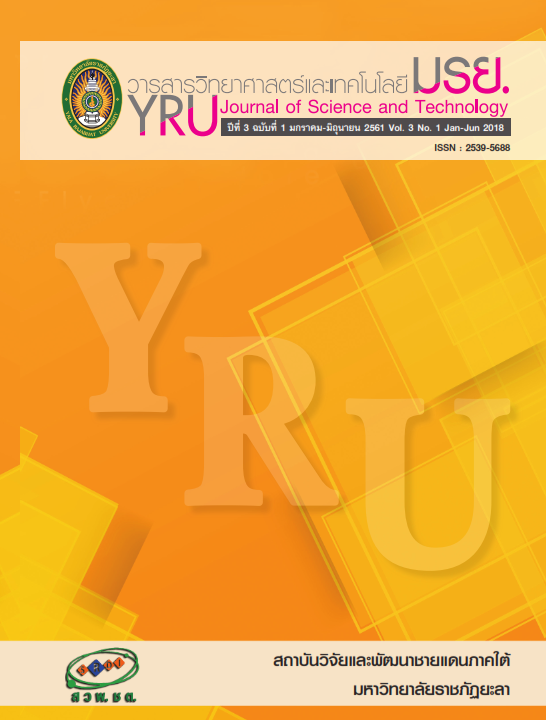ความหลากชนิดของนกตามเขตพื้นที่ริมน้ำที่สถานีวิจัยสัตว์ป่าดอยเชียงดาว จังหวัดเชียงใหม่
Main Article Content
บทคัดย่อ
การศึกษาความหลากหลายของนกที่สถานีวิจัยสัตว์ป่าดอยเชียงดาว จังหวัดเชียงใหม่ทั้ง 4 ลำห้วยซึ่งแบ่งเป็นลำาห้วยที่มีน้ำไหลตอดปีได้แก่ ห้วยแม่ก๊ะและห้วยแม่มาด และห้วยที่มีน้ำไหลในช่วงฤดูฝน ได้แก่ ห้วยอองและห้วยสี่ครอบครัว ซึ่งทำาการเก็บข้อมูลตั้งแต่เดือนเมษายน พ.ศ. 2554 ถึงเดือนพฤษภาคม พ.ศ. 2556 พบนกทั้งหมด 5 อันดับ 23 วงศ์ 48 ชนิด อันดับที่พบจำนวนนกมากที่สุดได้แก่ อันดับนกเกาะคอน (Passeriformes) และนกกินแมลงป่าอกสีน้ำตาลเป็นนกชนิดที่พบมากที่สุด รองลงมาได้แก่ นกปรอดโอ่งเมืองเหนือและนกปรอดเหลืองหัวจุกตามลำดับ ห้วยแม่มาดเป็นลำห้วยที่มีดัชนีความหลากหลายของนกมากที่สุด (28 ชนิด) รองลงมาคือ ห้วยแม่ก๊ะ (20 ชนิด) ห้วยสี่ครอบครัว (17 ชนิด) และห้วยออง (10 ชนิด) ด้วยค่าดัชนีความหลากหลาย 3.06 2.89 2.78 และ 1.53 ตามลำดับ เมื่อเปรียบเทียบดัชนีค่าสัมประสิทธิ์ความคล้ายคลึงพบว่าความหลากหลายของชนิดนกในห้วยแม่ก๊ะและห้วยแม่มาดมีความคล้ายคลึงกันส่วนห้วยสี่ครอบครัวและห้วยอองก็มีความคล้ายคลึงกัน ความอุดมสมบูรณ์ของชนิดนกในพื้นที่ศึกษาขึ้นอยู่กับปัจจัยทางกายภาพและปัจจัยทางชีวภาพของลำห้วย ซึ่งข้อมูลนี้มีความหมายสำคัญสำหรับการนำไปใช้ประโยชน์ในการอนุรักษ์พื้นที่ริมฝั่ง
Article Details
บทความ ข้อมูล เนื้อหา รูปภาพ ฯลฯ ที่ได้รับการเผยแพร่ในวารสารวิทยาศาสตร์และเทคโนโลยี มรย. นี้ ถือเป็นลิขสิทธิ์ของวารสารวิทยาศาสตร์และเทคโนโลยี มรย. หากบุคคลหรือหน่วยงานใดต้องการนำทั้งหมดหรือส่วนหนึ่งส่วนใดไปเผยแพร่ต่อหรือกระทำการใดๆ จะต้องได้รับอนุญาตเป็นลายลักษณ์อักษรจากวารสารวิทยาศาสตร์และเทคโนโลยี มรย. ก่อนเท่านั้น
เอกสารอ้างอิง
2. Boonkird, K., Wonghongsa, S., Rojanadilok, P., Niyomwan, P., Safuwong, M. & Soisook, P. (2007). Biodiversity of Wildlife in Doi Chiang Dao, Chiang Mai Province. Progress report on biodiversity in forestry and wildlife integrated. 349-361 pp.
3. Boonquarmdee, W. (2003). The diversity of birds in Doi Chiang Dao Wildlife Sanctuary at 550-625 m, Chiang Mai Province. Independent Study for Master of Science, Department of Biology, Faculty of Science, Chiang Mai University.
4. des Granges, J. L., Ingram, J., Drolet, B., Morin, J., Savage, C. & Borcard, D. (2006). Modelling wetland bird response to water level change in the Lake Ontario-St.Lawrence river hydrosystem. Environmental Monitoring and Assessment, 113, 329–365.
5. Fischer, R. A. (2000). Width of riparian zones for birds. EMRRP Technical Notes Collection (TN EMRRP-SI-09). Vicksburg: U. S. Army Engineer Research and Development Center.
6. Goldsmith, B. (1991). Monitoring for conservation and ecology. Great Britain: T. J. Press (Padstow) Ltd.
7. Gray, L. J. (1993). Response of insectivorous birds to emerging aquatic insects in riparian habitats of a tallgrass prairie stream. American Midland Naturalist, 129(2), 288-300.
8. Lekagul, B. and Round, P. D. (2005). A guide to the birds of Thailand. (3 rd ed). Bangkok: SahaKarnBhaet.
9. Leksawad, P. (1998). Doi Luang Chiangdao. Chiang Mai: Wanida Press. Levick, L., J. Fonseca, D. Goodrich, M. Hernandez, D. Semmens, J. Stromberg, R., et al. (2008). The Ecological and Hydrological Significance of Ephemeral and Intermittent Streams in the Arid and Semi-arid American Southwest. U.S. Environmental Protection Agency and USDA/ARS Southwest Watershed Research Center, 116 pp.
10. Machtans, C. S., Villard, M. A. & Hannon, S. J. (1996). Use of riparian buffer strips as movement corridors by forest birds. Conservation Biology, 10(5), 1366-1379.
11. Mansor, M. S., MohdSah, S. A., Koon, L. C. & Rahman, M. A. (2011). Bird Species Diversity in the Padawan Limestone Area, Sarawak. Tropical Life Sciences Research, 22(2), 65–80.
12. Munro, N. T., Fisher, J., Barrett, G., Wood, J., Leavesley, A. & Lindenmayer, D. B. (2011). Bird’s response to revegetation of different structure and floristics-Are restoration plantings restoring bird communities. Restoration Ecology, 19(201), 223-235.
13. Ngoenjun, P. (2010). Breeding ecology of the asian paradise flycatcher (Terpsiphone paradise) in Thailand. The Graduate School, Chiang Mai University.
14.Niyomwan, P. (2005). Biodiversity of Wild Animals in Doi Chiang Dao Wildlife Sanctuary, Chiang Mai Province. Progressreport on biodiversity in forestry and wildlife. 232-248 pp.
15. Owen, T. M., Jacob, D. H. & Margaret, A. (2011). Temporary Streams: The Hydrology, Geography and Ecology of Non-Perennially Flowing Water. River Ecosystems: Dynamics, Management and Conservation. Nova Science Publishers, Inc.
16. Orr, B. K., Diggory, Z. E., Coffman, G. C., Sears, W. A., Dudley, T. L. & Merrill A. G. (2009). Riparian Vegetation Classification and Mapping: Important Tools for Large-Scale River Corridor Restoration in a Semi-Arid Landscape. Proceedings of the CNPS Conservation Conference California Native Plant Society. 212-232 pp.
17. Pothasin, P., Compton, S. G. & Wangpakapattanawong, P. (2016). Seasonality of Leaf and Fig Production in Ficussquamosa, a Fig Tree with Seeds Dispersed by Water. PLoS ONE 11(3): e0152380. doi:10.1371/journal.pone.0152380.
18. Robson, C. (2000). A Field Guide to the Birds of Thailand and South-East Asia. Bangkok: Asia Books Company.
19. Schneider, N. J. & Griesser, M. (2009). Influence and value of different water regimes on avian species richness in arid inland Australia. Biodiversity Conservation, 18, 457-471.
20. Smith, C. M. & Wachob, D. G. (2006). Trends associated with residential development in riparian breeding bird habitat along the Snake River in Jackson Hole, WY, USA: Implications for conservation planning. Biological Conservation, 128, 431-446.
21. Welty, J. C. (1962). The Life of Birds. Philadelphia: W.B. Suanders Company.


